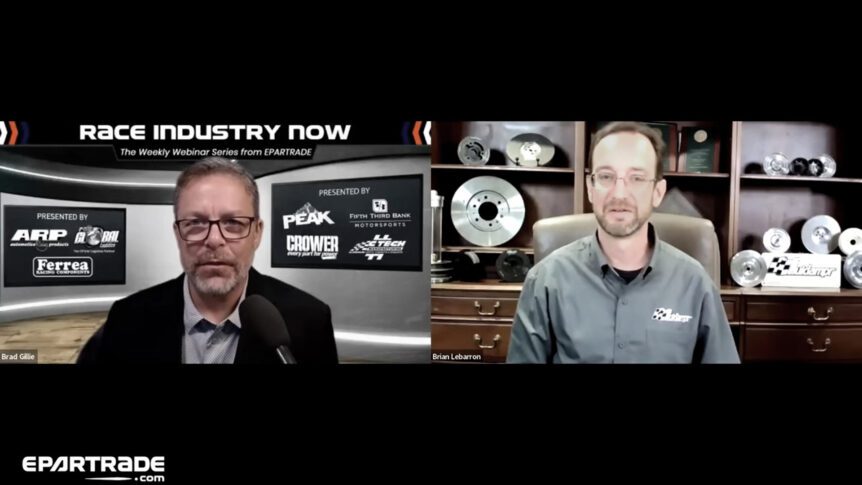As engine performance evolves, so too must the technology that ensures reliability under power. In a recent EPARTRADE webinar, Brian LeBarron of Fluidampr / Vibratech TVD delivered a deep dive into the role of torsional vibration dampers across motorsport, OEM, marine, defense, and industrial applications. His insights reinforced a core message: controlling torsional vibration is essential to crankshaft durability, engine efficiency, and long-term performance—especially as power density, RPM, and thermal stress increase in today’s platforms.
A Century of Engineering Expertise
Vibratech TVD, the parent company of Fluidampr, has been developing vibration solutions for over 100 years. Originating in 1919 (formerly Houdaille) and inventing the viscous torsional damper in 1946, the company’s technology was essential in the heavy-duty trucking sector growth. The transition to motorsports came in the 1980s, when professional teams needed dampers capable of withstanding the increasing demands of V8 race engines. This led to the founding of the Fluidampr brand, dedicated to high performance applications.
Today, Vibratech TVD and Fluidampr’s reach extends beyond racing to OEM programs in automotive, marine, and defense industries. The company operates with a clear objective: deliver OEM-quality solutions capable of surviving both peak race power and the long-term durability requirements of street and professional equipment.
What Is Torsional Vibration?
Torsional vibration is the twisting and rebounding of a crankshaft caused by combustion events, or torque inputs. Unlike unbalanced or axial vibration, which are controlled through balancing and thrust bearings, torsional vibration requires a damper specifically engineered to absorb and dissipate this rotational energy.
As LeBarron explained, torsional vibration can occur beyond a crankshaft; camshaft, driveline, and even electric motor shafts can experience it too. In modern high-RPM, high cylinder pressure engines, this twisting can accelerate failure, particularly when resonance is reached.
The Growing Demands on Dampers
Several trends are converging to amplify the challenge of torsional vibration:
- Higher Power Density: Modern internal combustion generates more power in smaller packages, often exceeding 6,000–11,000+ RPM. This increases frequency and often amplitude of crankshaft vibration.
- Thermal Stress: Tight engine packaging and reduced airflow cause more heat buildup. Dampers can degrade without adequate thermal management.
- Durability Expectations: OEMs demand dampers to last over five years and 60,000+ miles. Meanwhile, in motorsports, the demand is survival through full-race seasons, including grueling 24-hour endurance events.
Fluidampr addresses these demands with viscous dampers that adapt to a wide range of conditions. Unlike tuned narrow-range elastomer dampers common in stock engines, viscous dampers provide broad-range damping that adapts to changing frequencies and amplitudes across the RPM band.
Advancing Damper Technology
Fluidampr and Vibratech TVD have engineered a variety of innovative solutions:
- Traditional Viscous Damper: An internal inertia ring shears through silicone in a precision gap. The friction converts vibration into heat and is dissipated through the damper body.
- Nested Inertial Design: Dual inertia rings with a bearing allow for frequency-specific tuning, improving damping effectiveness across primary, secondary, and even tertiary torsional orders.
- Dual-Chamber Cooling: Expands heat dissipation capacity for high-output applications, especially in thermally limited environments like off-road or in-board marine engines.
- Oil-Cooled Dampers: Internal dampers cooled by engine oil jets provide thermal control at the highest levels of engine output—as used in a 1,000+ hp V12 OEM high performance engine spinning to 11,000 RPM.
- Twist Lock Housing: A patented modular design used in professional endurance racing, enabling post-race disassembly and silicone analysis. Tests showed these viscous dampers survived entire seasons, not just races.
From the Track to OEM Programs
LeBarron emphasized how data and designs proven in racing programs feed directly into OEM solutions. For example, the patented Twist Lock design was validated in a IMSA endurance prototype and demonstrated near zero performance loss over repeated race cycles. This kind of cross-industry development between race teams, OEM powertrain engineers, and industrial applications reduces development timelines, and validates long-term reliability.
Preparing for Hybrid and EV Powertrains
Torsional vibration challenges aren’t going away with electrification. Electric motors and hybrid drivetrains present new dynamic loads, frequency profiles, and packaging constraints. Fluidampr collaborates directly with manufacturers to map vibration signatures, measure packaging space, and engineer bespoke dampers for each application. While the fundamentals of vibration control remain unchanged, hybrid and EV platforms require fresh analysis and custom solutions.
Built for Performance. Made in the USA.
All Fluidampr and Vibratech TVD dampers are designed, validated, and manufactured in Springville, NY. The company’s vertical integration ensures rapid iteration, tight quality control, and the flexibility to support just-in-time programs for OEMs and motorsports teams. It also reinforces the brand’s commitment to American engineering.
“By leveraging our experience across racing, automotive, marine, and industrial sectors,” said LeBarron, “Fluidampr delivers advanced damping solutions that ensure both peak performance and long-term durability.”
Watch the full webinar:
Torsional Vibration Solutions for Peak Power & Durability
https://www.epartrade.com/video/faa407b7-torsional-vibration-solutions-for-peak-power-durability-da272cc0-epartrade

